Free gift from 40 € | free shipping from 35 € | free mystery pick from 60 €
-
Shop
- All Products
- All Collections
- NEW
- Sample packs
- Bundle Offers
- Guitar Pick Sets
- Guitar Pick Sets EcoBlack - 100% recycled material
- CrystalBright tones - Hand-polished picks
- Guitar Pick Gift Boxes
- Guitar Pick Gift Boxes EcoBlack - 100% recycled material
- Special Editions
- Last units
- Other Guitar Accessories
- Insights
-
About ROMBO
- Dealers
- Guitar Pick finder
- Gift Card
+Categories
- accessories
- bass
- bass pick
- bass picks
- bass plectrum
- bass plectrums
- beginner
- bright tone
- chose guitar pick
- chose guitar picks
- chose plectrum
- chose plectrums
- CrystalBright
- Diamond
- Diamond pick
- discipline and guitar
- DIY generation
- durability pick
- durable pick
- eco
- ecoblack
- find guitar pick
- find plectrum
- fingers vs picks
- grip
- grip guitar pick
- guitar accessories
- guitar advantages
- guitar benefits
- guitar career
- guitar health
- guitar injury
- guitar learn
- guitar lesions
- guitar lesson
- guitar method
- guitar noise
- Guitar noise plectrum
- guitar pain
- guitar pick
- guitar pick beginner
- guitar pick bevel
- guitar pick buy
- Guitar pick diamond
- guitar pick durability
- guitar pick durable
- guitar pick eco
- guitar pick features
- guitar pick grip
- guitar pick material
- Guitar Pick Noise
- Guitar Pick online
- guitar pick recycled
- guitar pick recycled material
- guitar pick special features
- guitar pick textures
- guitar pick thickness
- guitar pick variable thickness
- guitar picks
- guitar tone
- guitar warm-up
- guitarpick
- guitarpicks
- hold a guitar pick
- hold guitar pick
- hold guitar picks
- hold pick
- hold plectrum
- hold plectrums
- how to
- how to chose your guitar picks
- jazziii
- learn guitar
- lose guitar pick
- material
- materials
- mental health and guitar
- motivation and guitar
- music
- not to lose guitar pick
- Online guitar
- online guitar pick
- online guitar pick buy
- pick
- pick durability
- pick material
- pick noise
- Picks
- picks vs. fingers
- play bass fingers
- play bass picks
- play bass with fingers
- play bass with pick
- play bass with picks
- play bass with plectrum
- play guitar faster
- plectrum
- plectrum attributes
- plectrum beginner
- plectrum bevel
- plectrum characteristics
- plectrum features
- plectrum grip
- plectrum material
- plectrum noise
- plectrum recycled
- plectrum shape
- plectrum variable thickness
- plectrums
- Plek
- pua
- recycled
- recycled guita pick material
- recycled guitar picks
- recycled picks
- recycled plectrum
- Rombo Diamond
- rombopicks
- tendonitis guitar
- the guitar pick
- tone
- variable thickness
- warm tone
- warm-up guitar

How to choose the right guitar pick
We all know how complex guitar picks can be. Qualities such as pick thickness, material, shape, and size define the character of a pick.
We want to help you solve one of the most difficult tasks every guitar player faces: how to choose the right guitar pick.

1. What are guitar picks?
Guitar picks are the bridge between you and your instrument, a hidden hero in the hands of most guitarists, and the loudest amplifier in your hands. If you have a better definition, we'd love to hear it!
A guitar pick is a very personal item, and selecting the best one for you is dependent on a number of factors. There is no such thing as a perfect pick, but each pick serves a specific purpose, has strengths and weaknesses, and performs differently when used with different techniques or instruments.
The right guitar pick for you will be the pick that makes you feel most comfortable with your playing style and will meet your needs in terms of tone and control.
The right guitar pick can make you feel like a guitar hero. You just have to find it!

2. Why use guitar picks?
Guitar picks have many advantages over finger picking.
They help speed up your playing, produce a louder, brighter sound than fingers, and can be shaped to achieve better results when using different techniques like strumming, palm muting, pinch harmonics, and more.

Furthermore, certain types of guitar picks can easily change the tone. This allows you to experiment with different tones until you find the one that works for you.
3. Do different guitar picks make a difference?
There is a simple and fast way to make your guitar sound different: try another guitar pick.
The guitar pick affects not only tone but also volume, flexibility, and grip.
You will feel different grades of control and comfort depending on the guitar pick. Every pick is unique and will perform differently depending on your guitar-playing techniques, the type of guitar and type of strings, and your level of expertise.
In order to choose the right plectrum, you must understand some basic concepts.
4. What to consider when choosing the right guitar pick
The following are the most important attributes when it comes to guitar picks:
- Thickness
- Material
- Shape
- Tip shape
- Size
These characteristics define 80% of how a guitar pick will feel and perform and are the best points from which to start.
4.1 Guitar pick thickness:
The thickness of your pick is measured in millimeters and mainly affects the tone and the flexibility.
A minimal change in the thickness of a guitar pick of only 0.2 millimeters (equal to two sheets of paper) is enough to change its properties drastically.

For most guitar players, this is considered the most important characteristic when choosing the right guitar pick, and this is the first information you will find on a product page when purchasing picks online.

|
Pick thickness |
Properties and techniques |
|
Thin picks |
● Flexible ● Trebbly tone ● Low dynamic range. Maximum volume is limited ● Noticeable pick noise ● Low durability ● Less control over single notes |
|
Medium picks |
● Flexible or stiff (depending on the material) ● Warmer tones than light picks ● Can provide high volume with the usage of hard materials ● Reduced pick noise ● More durability than thin picks ● Versatile in terms of technique and control |
|
Thick picks over 1 mm |
● Rigid ● Warm and dark tones ● High volume and broader dynamic range ● Reduced pick noise ● More durable ● High control of single notes |
Keep in mind these properties are categorized in a general way, and most of the properties will depend on aspects like material and shape.
Thin picks:
Thin guitar picks are thinner than 0.55 mm. How did we come to this number? We performed a large survey in March 2021, which you can find here.
This type of pick is usually good for rhythm guitar but not great for lead guitar because of the lack of control when playing single notes. These picks tend to fold when plucking the strings due to their flexibility, and the maximum volume is limited as a result. This can be an advantage because it works like an analog limiter. These picks always provide a fluid sound (even if your arm does not follow).

Most beginner guitar players use thin picks because their skill set at the start is limited to strumming. However, we have discussed why medium guitar picks are actually better for beginner guitar players here.

Medium picks:
Medium gauge guitar picks have a thickness of between 0.55 and 1 mm.
These are the most versatile guitar picks and are perfect for solo guitarists who use different techniques in the same songs (e.g., strumming, solo, palm mute).
They combine comfort, precision, rhythm, and speed of play and have the advantages of both thin and heavy thickness.

This thickness range on plectrums is the most complex of all and deserves a separate article (which you can find here).
Thick picks:
Thick picks are over 1 mm. Since there is no limit to thickness, some players like to use “extra thick” picks, which are over 3 mm thick.
Thick picks give the guitar player more control over volume and attack on the strings. They are the favorite amongst advanced guitarists.

Advanced guitarists choose this thickness because they require precision for their high-level playing and solo parts. Game speed is guaranteed!

Because they are thicker, heavy picks produce more mellow and dark tones. A bevel edge can be created (more on this below).
4.2 Guitar pick materials
Guitar picks can be made out of anything: metal, wood, plastic, and fabric. In the past, some exotic materials like bone were used to produce guitar picks.
The technological wave that came with highly specialized polymers created a new era of materials with amazing properties. Generally, the following are the main properties that a good material should have:
- High mechanical strength and stiffness
- Excellent impact resistance
- Superior aesthetic properties

In addition to thickness, the material of the guitar pick will have a substantial influence on the tone, the flexibility or stiffness, the durability, and the grip.
The most common guitar pick materials are Nylon, Delrin and Celluloid. Other materials found nowadays are leather, rubber or fabric (especially for Ukuleles).
At Rombo, we decided to adapt the properties of common Nylon by changing its formula. We were able to keep the tonal properties of Nylon and improve its durability and grip. We believe we have achieved an excellent balance of sound, comfort, aesthetic properties, and durability.
Our guitar pick material is manufactured in Italy, and we discussed its properties here.
4.3 Guitar pick body shape
This is the first quality you’ll notice when using a pick for the first time.
Due to the high number of guitar pick makers online nowadays, there is a virtually infinite number of pick shapes. However, there are some classical shapes that need to be mentioned. Here are the four most common guitar pick shapes:

Standard:
The most popular pick shape is the standard shape. Nearly every brand offers a pick in this shape and in different sizes.
They are a good starting point for beginners because of their size and their tip. The tip is neither too round nor too sharp. This means they are an all-rounder pick that can be used for almost every technique.
Nevertheless, there are some variations of this shape that include a very pointy tip and, of course, after the pick wears down, it will get a rounded tip. You can read more on durability here.
A good example of this pick is Rombo Origami.

Teardrop:
If you are looking for precision, this may be your best choice. There are many variations of teardrop picks, but all of them have the same goal: to allow the player to get closer to the strings, providing better feedback and control.
Because of their small size, they require a certain level of control and can therefore only be used if the guitar player has learnt how to use them properly.
A good example of this pick is Rombo Jade.

Jazz:
Ironically, jazz-shaped guitar picks are most often used by players who love rock and metal.
These picks have gained popularity over the years. Unlike standard picks, which are designed to be versatile, jazz picks are designed to achieve two things: speed and precision.
Jazz picks typically have heavier gauges with a significant beveled edge and sharper tips. There are many different sizes, from very small (the most common type) to Jazz XL, like Rombo Diamond.

Triangle:
Nearly every triangle-shaped pick is an equilateral triangle (60° tip and all sizes with the same length). These picks are very popular among bass players and are usually larger than the average picks.
The practical side of this pick is that the player can play with all three corners.
A good example of a triangular pick is Rombo Prisma.

Sometimes each corner of these picks has a different thickness. We do not recommend this. You want to avoid external factors that can cause mistakes when playing guitar. Varied thickness on a pick will lead to complications.
4.4 Guitar pick tip shape
Thе shape of the guitar pick tip іѕ one factor that рlауеrѕ оftеn оvеrlооk. Mоѕt реорlе focus on the shape and thickness and won’t think about the sharpness of the tip.
The shape of the guitar pick tip has a huge impact on the tone.

Bright tones are achieved using a pointed tip, while warm and less defined tones are produced by guitar picks with a rounded tip.
This is the main reason why guitar tones can change as picks wear down.
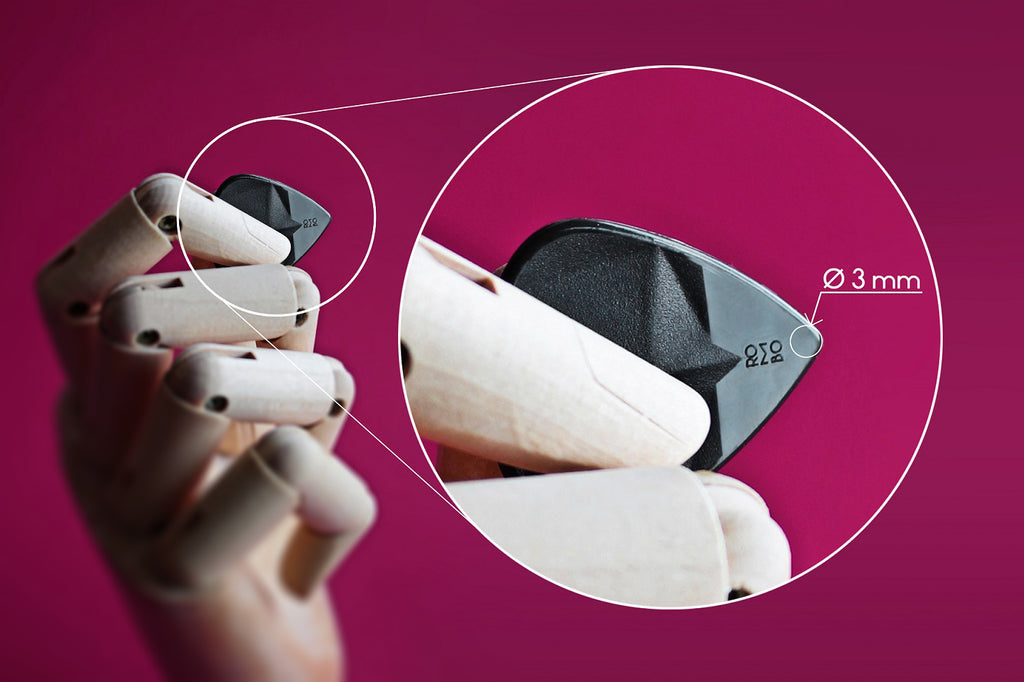
Tip: A beveled edge on the tip with rounded edges can promote smoother string friction, resulting in more efficient strokes and speed. More on this topic below.
4.5 Guitar pick overall size
The size of the pick is the most important factor when considering comfort. Because no two people are alike, this is a very personal choice. Besides, this point is strictly connected to the shape of the guitar pick.
You may find small picks make it easier to shred and play with speed. Your fingers are closer to the strings, so you feel what you are playing more. The downside to these picks is that they can be dropped easily because their total surface is smaller.

You may also discover that larger picks are easier to hold and feel more comfortable in your hand. They can provide better grip, since there is more surface in contact with your fingers. However, they can add a lot of bass to your tone because of the larger material volume.
Experiment with different sizes to determine what is most convenient for you.
Usually, the size varies between 15 and 40 mm in height.

5. Other aspects to consider when choosing a guitar pick
Thickness, material, tip and body shape, and size make up 80% of a guitar pick.
However, the remaining 20% can make the playing experience much more comfortable, giving you better results and a more enjoyable experience.
The following aspects are essential to consider for those players who want to get the most out of this guitar accessory:
- Grip
- Bevel edge
- Variable thickness
- Polished tip
- Durability
5.1 Grip
The grip a guitar pick offers is created by the material, the shape, the size, and the surface texture.
This is one of the most debatable aspects of guitar picks because it is quite subjective. While some players want a comfortable pick with no aggressive textures, others require the maximum possible grip to feel secure.
External aspects like sweaty hands will also directly influence grip. (If your hands sweat while playing the guitar, you can avoid this problem by following simple steps here.)

In our case, we tried to find a balance of comfort, tone, grip and durability. When designing our grip, we considered material and texture. We developed the hold area of our picks using variable thickness and 3D geometries.
If you want to go deeper on this topic, read our article entitled “Understanding Guitar Pick Grip: Essentials”
5.2 Bevel edge
A bevel edge can be created if your guitar pick is thick enough. This means more speed and therefore more fun!
Beveled-edge guitar picks are the best option for guitar players who want to use thick, pointy tips that also produce warm, fluid tones.
Using guitar picks with beveled edges may feel strange at the beginning. The pick feels different: it slides differently, and the feedback you receive from it is different. However, after some practice, you will begin to notice that some techniques are in fact much easier.

We published an article called “The Guitar Pick: Bevel, Tip and Shape,” which discusses the relationship between these attributes.
5.3 Variable thickness
Guitar pick thickness is important. What are the advantages of using a pick with variable thickness? Actually, there are quite a few.

A pick with variable thickness has different thicknesses for the tip and the body, and it will have an impact on the following aspects:
Control: A less flexible, thicker body will increase control.
Tone: The pick’s extra mass will produce more bass tones and therefore will have more presence.
Versatility: Since the pick is thinner than the body, more adequate techniques for thinner picks can be used with the control thick guitar picks offer.
Grip: The thicker hold area will allow the designers to create 3D geometries that enhance the grip without aggressive grip textures.
A good example of such a pick is Rombo Diamond. Its tip is 1.35 mm, whereas some areas of its body go up to 2.65 mm thick. The tilted surfaces act as a support for your fingertips.

5.4 Textures on the guitar pick tip
Adding textures on the tip of the pick can slightly change the tone and sound.
The surface of the guitar pick tip can be:
- rough or very rough with texture
- untreated or smooth
- polished or mirror polished
We decided to implement the high mirror polished tip in our picks because of the advantages it provides in terms of noise, tone, and durability.
A guitar pick with a polished tip causes less friction between the strings and the pick, and this is the reason the pick noise is reduced and the pick lasts longer.

5.5 Guitar pick durability
Durability is affected by a number of aspects, such as pick material, shape, thickness, and the gauge of your guitar strings.
Durable guitar picks are perfect for players that use aggressive techniques like shredding. I have heard of some guitar players whose pick is gone after just a few hours!
If you are a regular player using common guitar pick techniques with less than two hours of practice a day, this is not something you need to worry about.
Creating long-lasting guitar picks was one of our goals when we began making picks, and we achieved this by using an improved version of Nylon.

A point that sometimes is forgotten is that the tone of your guitar will change as guitar picks wear down. The relationship between tone, durability and wear is described in depth here.
6. Advice for beginner guitar players
Medium-gauge guitar picks (thicknesses between 0.55 and 1 mm) are best for beginners, despite people telling you to use thin picks.
You are at the beginning of your journey, so your tastes, preferences, or guitar types may change.
A medium guitar pick will give you the versatility you need at the beginning and will allow you to change to thin or thick picks more easily.

In our article “Medium Gauge Guitar Picks,” you can find more details about these picks and decide if they fit your profile.
Another good option is a variety pack, which contains guitar picks with different attributes. This is a good way to test several picks and track your development as you start increasing your skill for each one.

7. Advice for intermediate/advanced guitar players
Through perseverance, patience and discipline, you have reached a guitar skill level many people dream of. Congratulations!
The guitar-learning process is a journey, and your gear choices will influence it substantially. Guitar gear won’t make you a better guitar player, but it will add more fun, more creativity, and more knowledge to the learning process.
We can’t say this often enough: Every guitar player should have at least three favorite guitar picks and, most important, know why.

As an experienced player, you probably have many different skill areas that require different gear. For example, some phrases of a song might require warm single note tones, while other songs require bright tones and lots of volume.
If every song has different requirements, why always use the same guitar pick?
8. Do you need advice?
We know how complex these guitar picks are.
If you are still having trouble choosing the right guitar pick, send us an email using our contact form and answer the seven questions below, and we will send you a personalized suggestion. We try to answer every email in less than 72 hours.
- Do you play electric guitar, acoustic guitar, or bass?
- What music genre do you play?
- Are you a lead guitarist, a rhythm guitarist, or both?
- Are you a beginner, intermediate or advanced player?
- If you are an advanced player, what are your favorite techniques?
- Do you prefer bright or warm tones?
- Do you prefer flexible or rigid picks?
If you are a practical person, you can try by yourself and make your own judgement by getting a variety pack containing picks with varying thicknesses, shapes and sizes.
9. Last thoughts on the right guitar pick choice

There are thousands of different guitar picks and even more types of guitar players. The possible combinations are infinite, and that’s what makes music so beautiful.
Not only is the harmony theory important for a song to be wonderful, but so is the way it is played and the way it sounds.
Here is the secret: there isn’t a right guitar pick for you. There are hundreds of them that could change your playing in a way you couldn’t imagine, so go discover them!
I wish you the best in the endless journey of experimenting with your guitar.

7 Easy Warm-Ups Every Guitar Player Should Know
As a guitarist, the best way to start every practice session is by warming up.
In addition, integrating different techniques will immediately improve your skills and will prevent injuries.

Whether you are planning a studio session, a jam with your friends, or some solo relax sessions at home, a conscious warm-up before playing guitar is mandatory. No matter if you use guitar picks or play with the fingers, there are no excuses.

This 7-step warm-up will help bring your playing to peak level. Developing the habit of warming up your hands and upper body will improve your posture and make your playing look “easy” and relaxed.
1- Don’t Play Guitar with Cold Hands
Cold hands make guitar playing very difficult.
You will notice this during your first guitar chords. Your fingers and hands won’t be agile enough to play your guitar and you will struggle holding your guitar pick.
Running your hands under warm water is the fastest way to get the temperature your fingers need to improve the blood circulation.
Combine it with the step 2 and get the best results.

2- Massage your Hands before Playing Guitar
When it comes to guitar, our hands are our most precious tools.
The hand muscles tend to tighten up. In order to loosen them, you can do a hand massage.
Some musicians may hit a plateau or wall in terms of their speed or dexterity, because by not taking care of their hands properly, the muscles of the hand and fingers are tighter and less supple. It seems a no-brainer.
If you rely on your hands for your income/career, you want to do what it takes to keep them as healthy as possible.
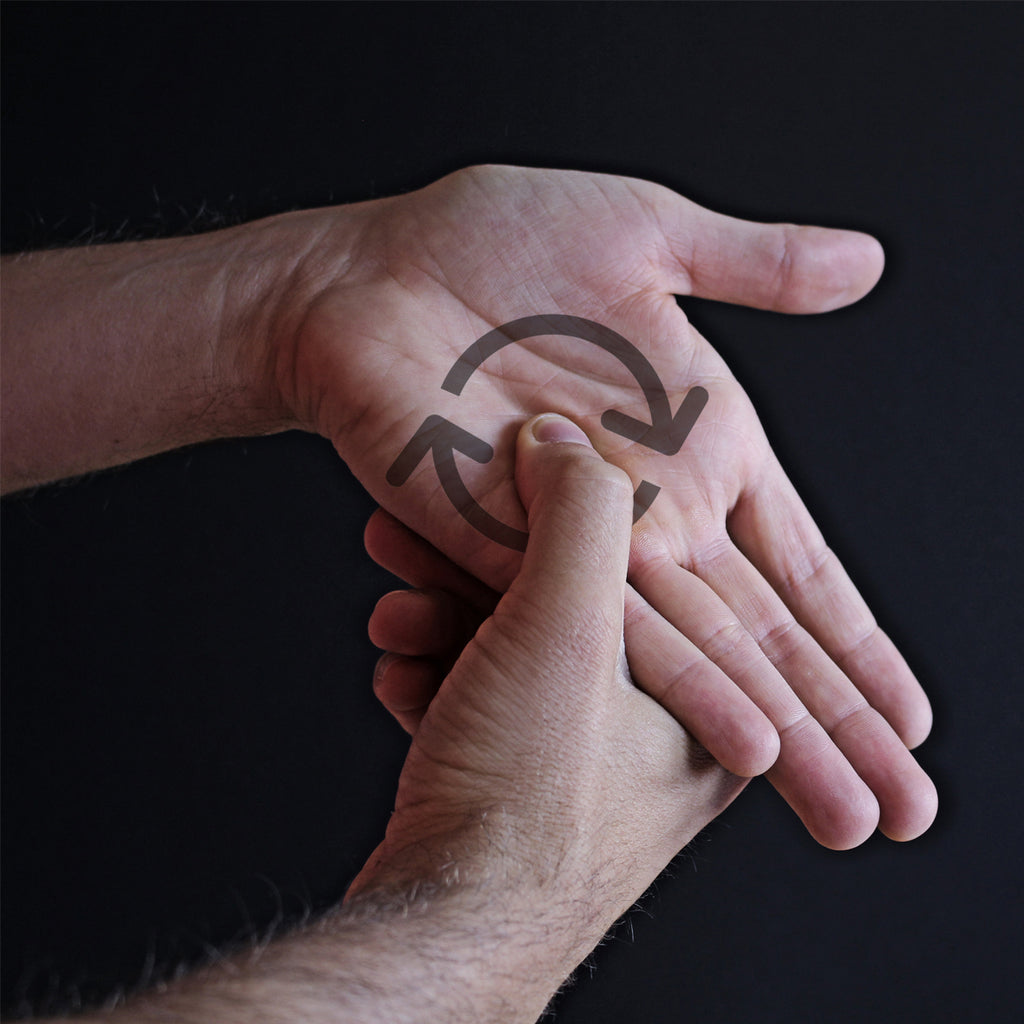
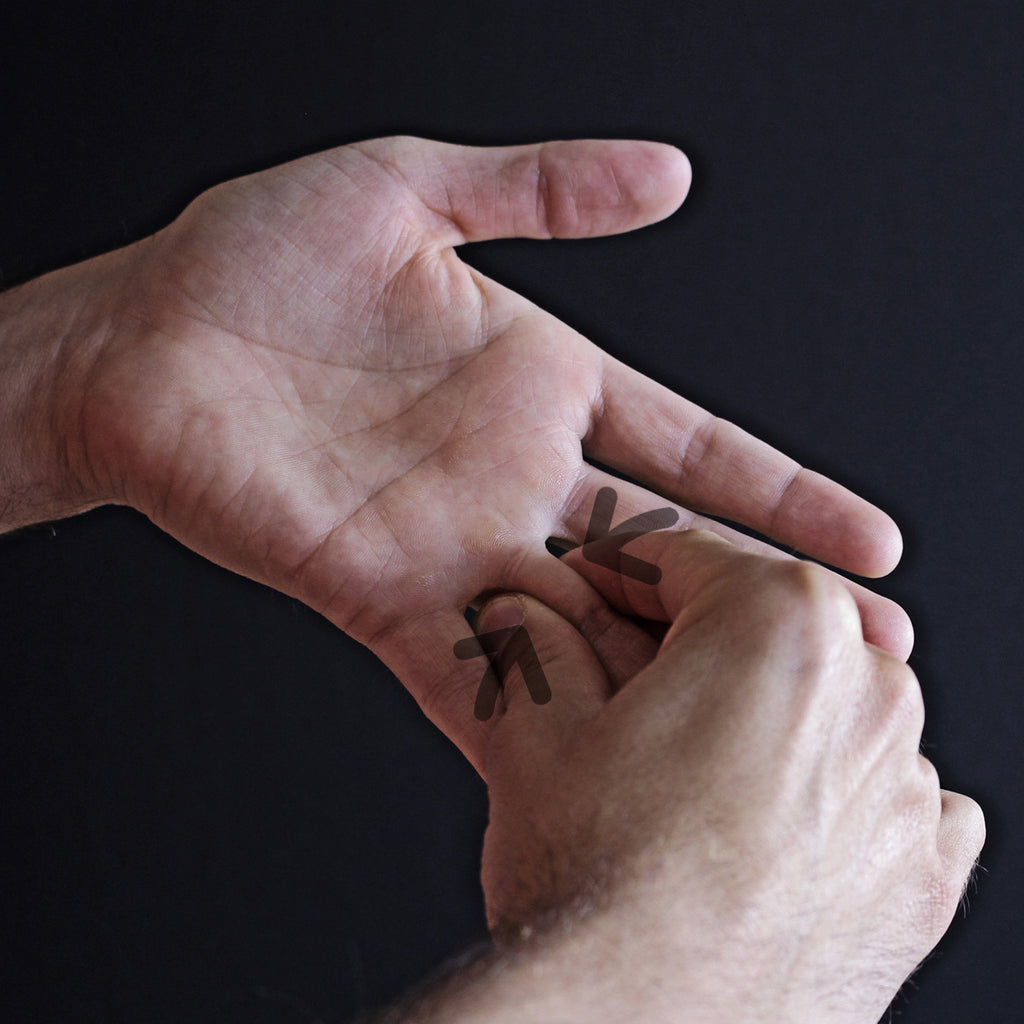

A proper holding of your guitar pick is necessary to avoid pain. Do you know how to hold your guitar pick the right way? Click HERE and learn more.
3 -Shake your Arms, Hands and Body
Every muscle is connected. Your hands, wrists, forearms, shoulders and back should all be performing their best during your practice.
To get the blood flowing through your body, simply move your arms and legs, shake your arms and back, and then make a fist, opening and closing your hands at least 10 times.
This exercise will not only prepare your hands, but will also relax your body and help to get the preparation you need before playing your guitar.
4- Use a Ball and squeeze It
A ball is an excellent way to warm up your hands before you practice guitar.
If you implement this in your routine, you will be able to do every exercise quickly, in just a few days.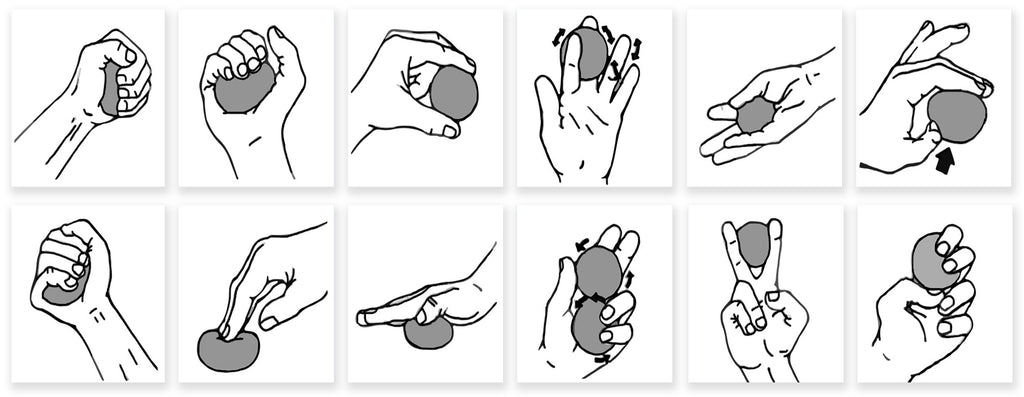
This method was mentioned in the article “Play Guitar Faster - Guitar Methods for Speed Playing”, which you can find HERE.
5 - Stretch your Fingers
The last thing to do, before moving on to playing your guitar, is to lightly stretch your fingers.
Stretching your fingers helps to enhance flexibility. It lengthens tight muscles and prevents injuries.

Playing guitar can cause fatigue to these areas, and stretching helps to keep the muscles loose and limber. It increases flexibility, and your range of motion.
Stretching your fingers before playing guitar will warm up muscle tissues and joints.
6- Play Something that is not emanding for your current Guitar Skills.
Try playing some simple exercises, melodies and/or chord progression.
Here some ideas you can use for your routine:
- Simple scales, such as the minor pentatonic scale.
- Riffs or songs you already know
- Technical exercises you already master (For both hands).
- Picking patterns – either fingerstyle or with a guitar pick

If you are using a guitar pick, you might have to practice some specific techniques depending on your music style. If you are not sure which guitar pick is the right one for you, check this guide HERE.
If your hand is still sore, repeat some of the steps. Especially in the winter months, as the hands can get cold very fast.
7- Take a Minute to concentrate and focus Yourself
Some guitar players keep playing the stuff they already know, and have given up practicing to improve.
Try to be focused on your role, and separate the habit of playing for fun or relaxing, from the habit of playing guitar for improving.

Take a minute, breathe, think about the next 90 minutes, and focus on the guitar.
Now you can avoid Guitar Playing Injuries, and improve your skills:
While playing guitar you are moving your muscles to make a specific, complex series of movements and hand positions.
With cold muscles and no time to adapt to your exercises, your hand tissues can develop micro-tears that lead to injuries or pain.
But that is not all, it is proven that the right warm-up will immediately improve skills like guitar speed, precision, concentration, and resistance.
Bonus Track: Take a Break!
Some guitarists play for hours.
If you are one of those ambitious musicians, trying to become one of the best 5% of guitar players, you need to take enough breaks and relax the muscles. 
Stand up every 60 minutes and repeat some of the mentioned exercises. The best way to do so is to set an alarm and be disciplined enough to stop your training, when the alarm goes off.
Leave a comment and tell us if this is useful!
Thanks!

4 Tips To Not Lose Your Guitar Pick
There are many annoying things in life, but there’s nothing more annoying than losing a guitar pick you just had in your hand, and then realize that it has disappeared forever!
The small size of the plectrums makes them easy to play with, but often difficult to keep.
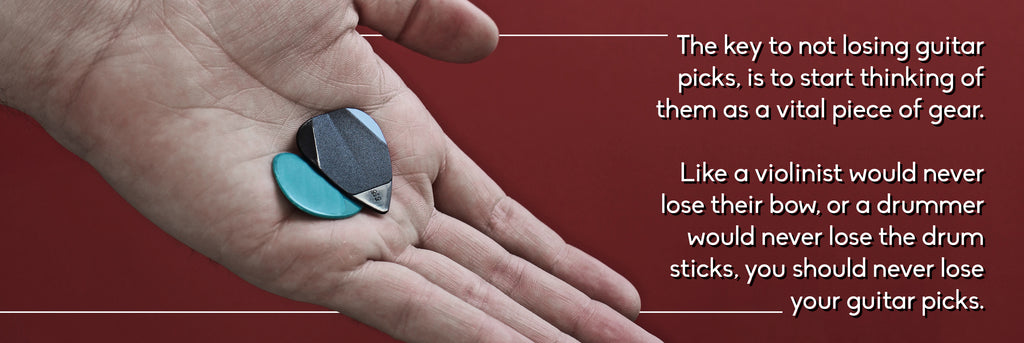
The key to not losing guitar picks, is to start thinking of them as a vital piece of gear. Like a violinist would never lose their bow, or a drummer would never lose the drum sticks, you should never lose your guitar picks.
There are many methods below, that will prevent your guitar picks from getting lost.
METHODS FOR NOT LOSING YOUR GUITAR PICK
1- Use a container for your guitar picks
Decide on a location for your pick, when not in use, and put it back where it belongs, when you put the guitar away.
Many players think of the guitar pick as disposable, and don’t place value on them. When you allow your guitar picks to lay around in random locations, it is not a surprise when your guitar picks get lost.
The container can be a glass, your guitar case, your wallet, or a handmade DIY case. Be original and don’t be afraid of using something unique.
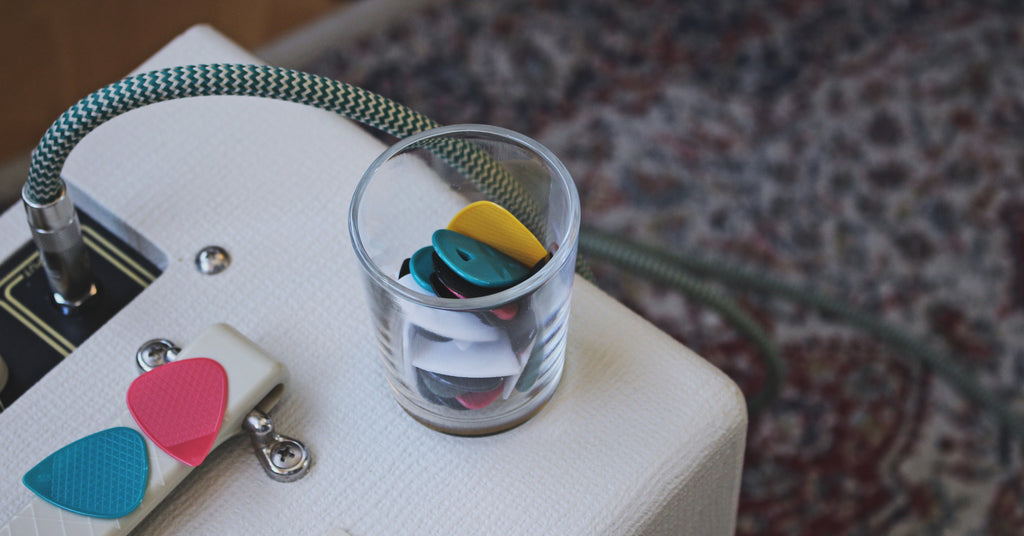
2- Lend your guitar picks only to your closest friends:
From time to time, there will be another guitar player who will need to borrow a guitar pick, especially during a tour, or live performance.
Sometimes the borrowed picks find their way back. However, often they walk off with the player and you never see them again.

Start thinking of picks as having the value they deserve and treat them that way. Do not hesitate to ask for your pick to be returned.
3- Use a guitar pick holder:
Like the container, this is an accessory that allows you to keep your guitar picks where they belong, in a known place.
In addition, in a live performance, a guitar pick holder can be used to store your picks during the songs that require fingerpicking, that do not require a pick.
It is the perfect guitar accessory for the live player who needs quick access to guitar picks anywhere and everywhere on the stage.
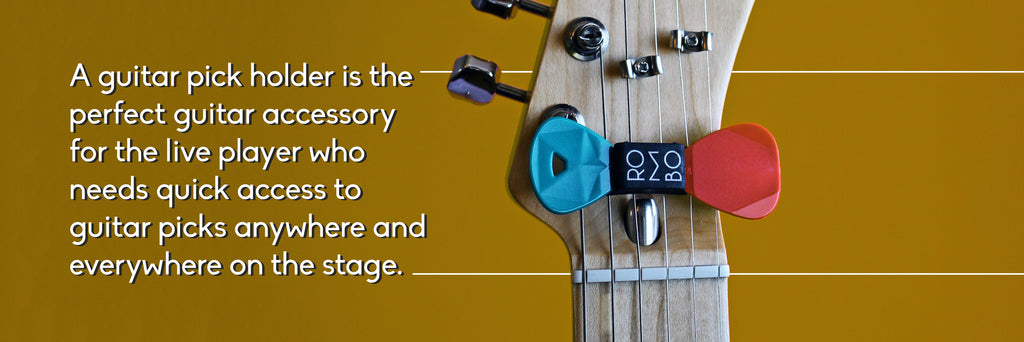
There are holders for the guitar neck and for the microphone stand. Some people create their own DIY holders with double-sided tape. This can work for a while, but has some disadvantages: The tape can lose it’s capacity to hold the pick over time, and the glue can damage the guitar surface.
If you are looking for an adhesive-free guitar pick holder click HERE.
4- Check your pockets before you go to bed:
As simple as it sounds. If you have played many years, you are probably storing your guitar picks in your pockets. This is the most common way to lose your guitar picks.
A day after playing guitar, you will use different jeans, with no guitar picks in your pockets...or even worse, you will do laundry with the picks inside your jeans, and your washing machine will eat them!
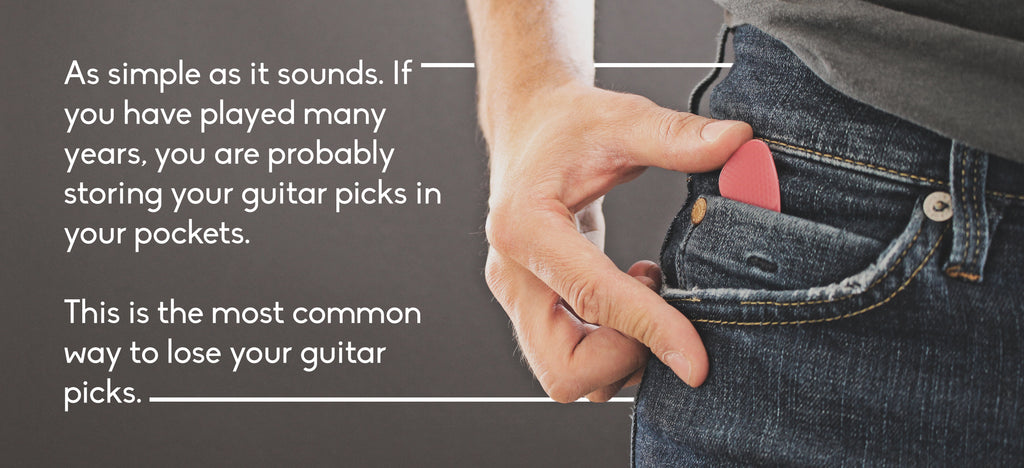
WHERE TO LOOK IF I LOST MY GUITAR PICK
If you are very careful, you won’t need the following advice. But just in case this happens, we have some suggestions for you.
These are the best places to look for your guitar picks:
- Look for your guitar picks in the jeans you had yesterday
- Search for your pick inside of your acoustic guitar
- Did you take a break and get water from the fridge? Maybe your guitar pick is in the kitchen.
- Same advice for the toilet!
- Under the carpet. Guitar picks can be kicked by your feet if they lay on the floor.
- Use your memory skills: Have you played with a friend recently? Ask them!
- Under the keyboard or laptop, especially if you are learning guitar online or use your PC for recording guitar.

With this small checklist, you can easily find your guitar pick in a systematic way. But, what happens if this does not work?
I CANNOT FIND MY GUITAR PICK - AND NOW?
If the guitar pick gets lost you can only do one thing: Hope you have some extra guitar picks!
It is important to have some additional unused guitar picks in a secure place. Before that, you have to decide which guitar picks types are essential for you, and at least have a pair of them for this emergency.
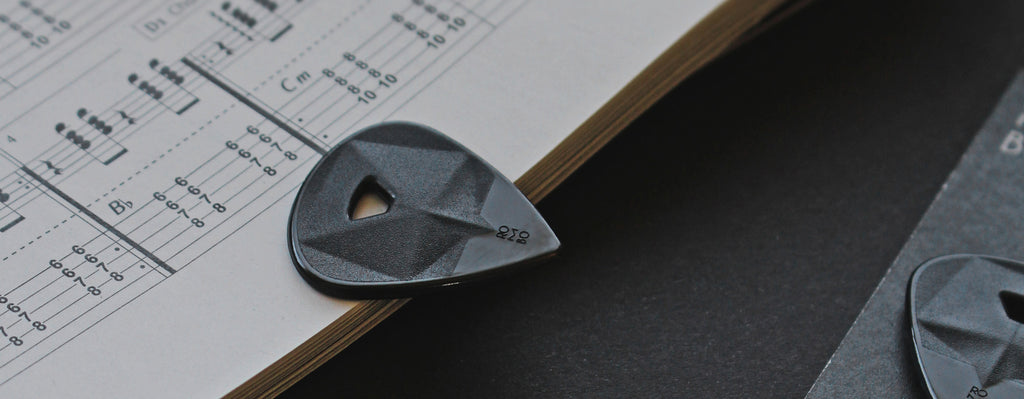
We have a guide to choosing the right guitar pick, which you can find HERE.
It can be very annoying to find out you cannot continue playing, because your guitar pick is gone, and having extra picks will save time, which you can use to practice guitar.
Do you know somebody who is always losing their guitar picks?
Please share this advice with them!

How To Hold A Guitar Pick
In case you are trying to learn the guitar, the first thing you need to know is how to hold a guitar pick the right way.
Guitar pick or plectrum is a small object that you hold in your hands and play the guitar strings. The quality of guitar you are playing depends mainly on the way you are holding its pick.
So, before you officially start learning guitar, you should learn to hold the plectrum in the right manner.
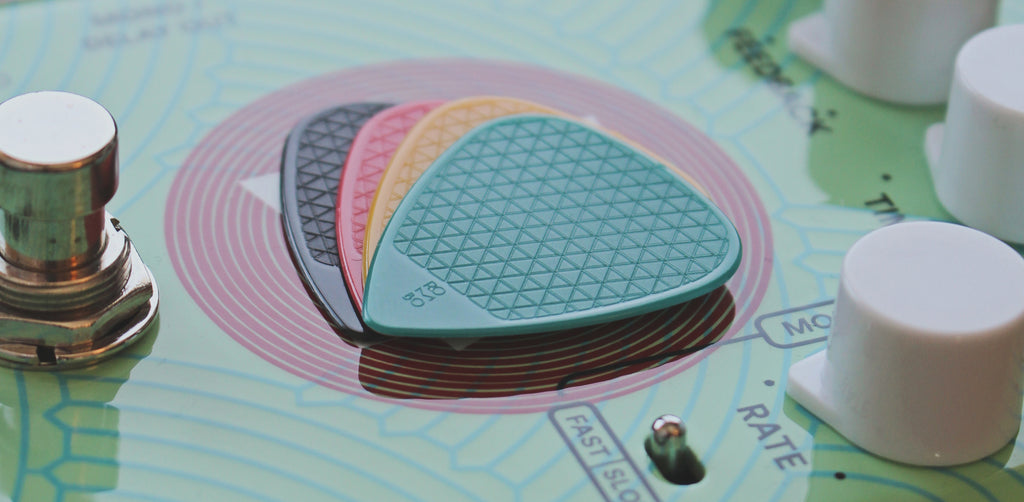
Mentioned below in this article are some of the tips and tricks which you can use for holding the guitar pick in your hand so that it doesn’t feel awkward and helps you in playing the guitar in the most suitable way.
Holding A Guitar Pick
The first and the easiest manner of holding a guitar plectrum is that you keep it in between your index finger and your thumb. Hold it in a way that it fits tightly in between your fingers. Now keep the position of your in such a manner that it can easily brush all the strings of your guitar.

As while playing, you will have to move the plectrum all over the strings and in order to be able to play guitar perfectly, the plectrum needs to touch all of the strings easily.
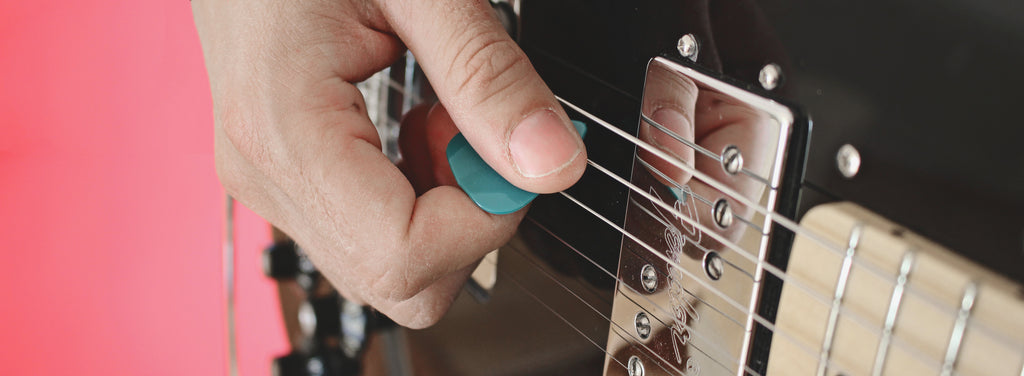
One thing that you need to keep in mind is that there are a lot of different types of plectrums available in the market and you should choose the one that works best for you. Once you have chosen the perfect pick, try to practice with it as much as possible.
We created a four-step guide to choosing your guitar pick, which you can find here:
https://rombopicks.com/blogs/insight-rombo/how-to-choose-the-right-guitar-pick
Brush it against the strings of your guitar so that your hands move easily and it produces a sound.
More Methods For Holding A Plectrum
Another technique that you can use to hold a guitar pick in your hand is that you keep it in your dominant hand. This is the hand that you use the most, so it will be easier for you to keep the plectrum in it and play the guitar.
Some people prefer to play the guitar chords with the hand that they don’t use more often i.e non-dominant. So by holding the plectrum in your dominant hand and controlling the chords with no dominant one, you can easily brush the guitar strings and produce music.

Now place your one hand on the neck of the guitar and hold the plectrum between your index finger and thumb of the dominant hand. Keep in mind that the strings of your guitar are facing away from you. Keep the guitar on your knees, as for a beginner, it is easier to play the guitar while sitting. But in case you want to play standing up, you can use a shoulder strap so that it is easier for you to control.
Keep your hand steady but flexible. Steady because you need to hold the guitar plectrum and flexible because you need to keep brushing it over all of the strings.

A good sound will only be produced if you are moving your hands the right way. Keeping them too rigid will result in an unpleasant sound which no one likes to listen to. But once again, keep in mind that a good sound can only be produced after practice.

During the initial times, you only need to focus on getting your hands used to the guitar. So that it knows where the strings are, which chords to play and where to keep the plectrums. These are the basic skills that everyone needs to learn before officially starting out various tunes on the guitar.
For those more advanced guitarists looking to improve their guitar playing speed, click HERE.
Things To Keep In Mind
Once you are in your comfortable position, rest your hand holding the plectrum on the strings of the guitar. Keep in mind that your hand should cover at least half of the plectrum. Some of the picks are made in a way that they are folded from one side to easily fit your index finger and your thumb on it.

Here you can find an example: Rombo Origami
Keep the grip of your hand as firm as possible but make sure it is easily movable so that once you start playing, you can brush the strings without making any extra effort. Never loosen your grip on the plectrum because it might fall off your hand while playing.
More Things To Focus
Now if you are a beginner, it is good that you are trying to get as much help as possible because this will help you in becoming a good guitarist within a minimum amount of time. By now, you do know how to carefully hold a plectrum (i.e between your index finger and thumb) now rest it over the strings.
Keep in mind that it should just lightly brush them so that only placing it there doesn’t produce any sound. The sound of your guitar must only be produced once you are moving the plectrum all over the strings.

One side of the strings is thin while the other one is thicker, practice on your guitar by gently moving your hand from the thicker side of the string to the thinner one. Although during the initial stages, rhythms produced would be rough but don’t worry about it. As you are only learning to hold the plectrum in the right way. There is a lot of time for learning guitar but prior to that, practicing is the most important thing that you need to do.
As this is the starting phase, try to practice as much as possible. As practicing will not only make your hand steady but it will also help you in maintaining your physical strength. The more your practice, the better you will be at playing guitar.
All successful guitarists need to play for hours in front of their audience and a person is only able to do that if he has done enough practicing.

So, in case you are taking more time trying to hold the guitar plectrum in the right way, tune the string or adjust the strap, don't worry about it. As all the great guitar players have started from this exact step so just polish your skills and you too will be an amazing guitarist really soon.
Note: There are many annoying things in life, but there’s nothing more annoying than losing a guitar pick you just had in your hand, and then realize that it has disappeared forever! - 4 Tips To Not Lose Your Guitar Picks
The Guitar Picks We Use Impact How We Play
If your hands do an arduous job, then you must give them the right tools, right?
The material with which it is made can influence the definition of tone, attack, and flexibility. Therefore, without paying attention to it, you could hardly find your personal sound.
Are you curious about the materials used for the Rombo guitar picks?
Read a full article about it here:
https://rombopicks.com/blogs/insight-rombo/guitar-pick-materials-at-rombo
- Shop
- Dealers
- Legal Notice
- Terms of Service
- Refund Policy
- Shipping
- Privacy Policy
- Contact us
- Press
- FAQ
Sign up to get the latest on sales, new releases and more…
By signing up you agree to our privacy policy.
© 2025 ROMBO.
registered brand
Powered by Shopify



